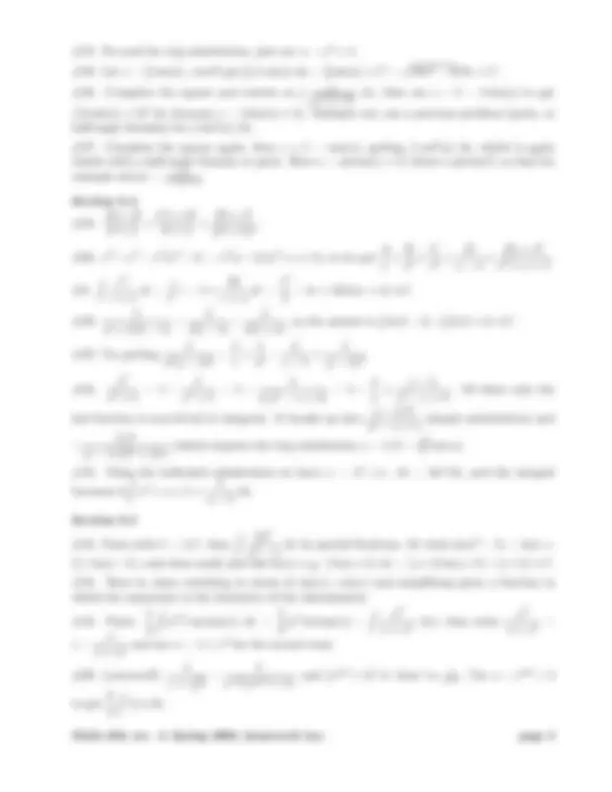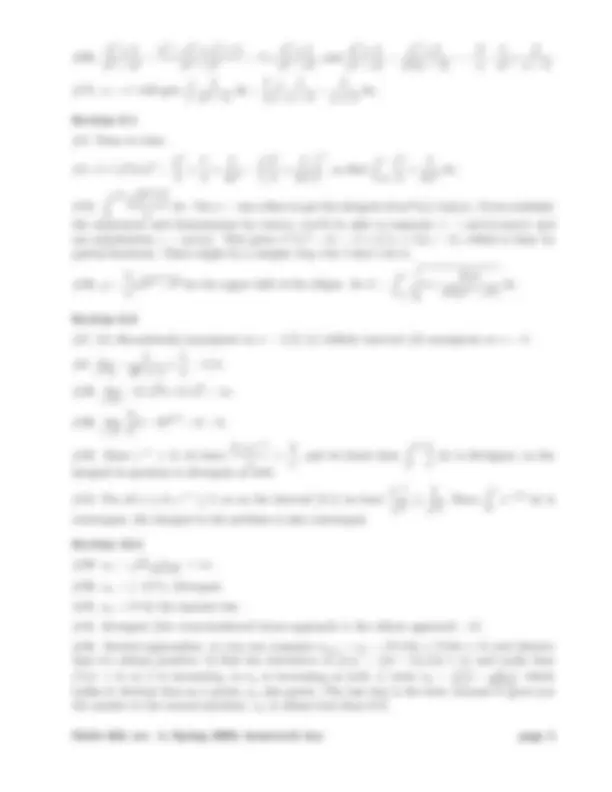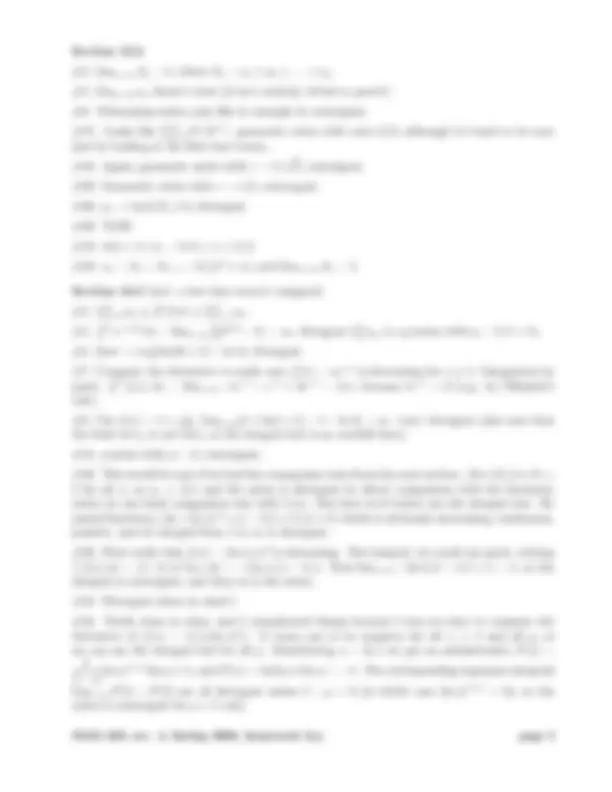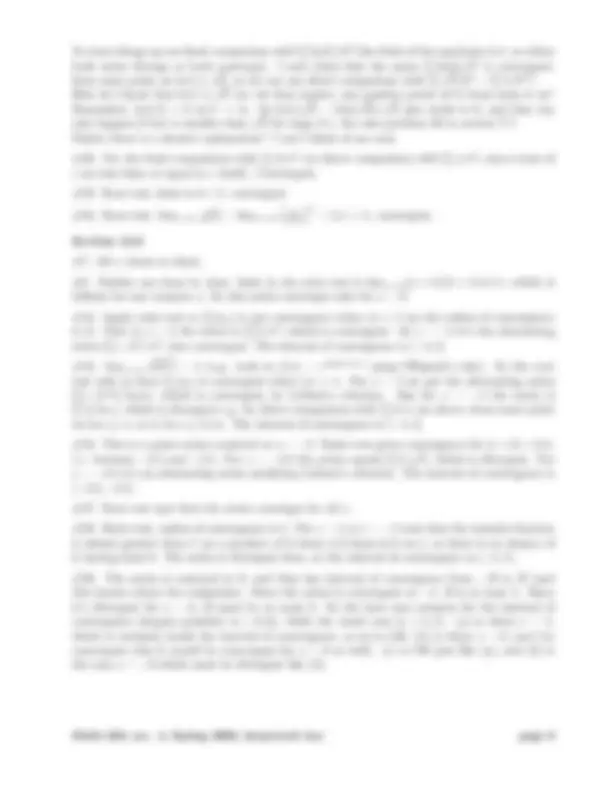






Study with the several resources on Docsity

Earn points by helping other students or get them with a premium plan


Prepare for your exams
Study with the several resources on Docsity

Earn points to download
Earn points by helping other students or get them with a premium plan
Community
Ask the community for help and clear up your study doubts
Discover the best universities in your country according to Docsity users
Free resources
Download our free guides on studying techniques, anxiety management strategies, and thesis advice from Docsity tutors
Material Type: Assignment; Class: Calculus II; Subject: MATHEMATICAL SCIENCES; University: Northern Illinois University; Term: Spring 2006;
Typology: Assignments
1 / 8

This page cannot be seen from the preview
Don't miss anything!





Section 7. #3. (a) π/ 3 (b) −π/ 4 #16. Graphs of y = tan x (−π/ 2 < x < π/2) and y = arctan(x) are symmetric about the line y = x.
#26. f ′(x) = ln(arctan x) + (^) (1 + x (^2) ) arctanx x.
#29. y′^ = −^2 e
2 x √ 1 − e^4 x^.
#30. y′^ = √ 1 − −x x 2 + arccos x + √ 1 x− x 2 = arccos x.
#45. (^) xlim→∞ ex^ = ∞, so limx→∞ arctan(ex) = π/2.
#50. Done in class. #66. u = arctan(x) gives (arctan x)^2 /2 + C.
#72. V = π
∫ (^2) 0
x^2 + 4 dx^ =^
π 2 arctan(x/2)
∣∣ ∣∣^2 0 = π^2 /8.
Section 7. #6. Cancel x + 2 in the fraction, or use l’Hˆopital to get −1. #9. Done in class, −∞. #15. (^) xlim→∞ 1 /x = 0.
#26. lim x→ 0 cos 3 xx^2 − 1 = lim x→ 0 −^ sin 6 x x= − 1 /6 (I made a mistake here at first).
#28. (^) xlim→∞ 2 /x = 0, so lim x→∞^ 2 lnx x= 0.
#41. Write as lim x→∞^ x
3 ex^2 and apply l’Hˆopital’s rule twice to get lim^ x→∞
4 xex^2 = 0.
#48. Write as lim x→ 1 x (^ x− −^1 1) ln−^ ln xx , then use l’Hˆopital’s rule twice (simplify as you go!) to get
xlim→ (^1) 2 + ln^1 x = 1/2.
#60. Done in class; lim x→ 0 5 ln(cos 3 x x)= 0, so the answer is e^0 = 1.
#88. For any p > 0 we have an indeterminate form ∞/∞, so l’Hˆopital’s rule applies. Since
xlim→∞ xpx^1 p−^1 = limx→∞ px^1 p^ is 0 for any positive^ p, the original limit was 0.
Section 8. #3. Letting v = 15 sin(5x) I get 15 x sin(5x) + 251 cos(5x) + C.
#8. Parts twice, each time expressing the trig function as a derivative( v′: first write cos mx = m^1 sin^ mx)′^ , then sin^ mx^ =^ (^ −^ m^1 cos^ mx)′^. You should get something like 1 mx
(^2) sin mx + 2 m^2 x^ cos^ mx^ −^
m^3 sin^ mx^ +^ C.
#14. Parts three times, each time writing et^ = (et)′; should be t^3 et^ − 3 t^2 et^ + 6tet^ − 6 et^ + C. #25. Use v′^ = (x)′^ and then substitution u = 1 − x^2 to get x arccos x −
1 − x^2. Evaluates to π/ 6 − √ 3 /2 + 1. #26. Write 5x^ = (5x/ ln 5)′. I’m getting 5/ ln 5 − 4 /(ln 5)^2. #36. u = x^2 to get 12 ∫^ u^2 eu^ du, then do just like #14. #52.∫ 5 5 ln x = x ln x when x = 1 and x = 5, and in that region 5 ln x ≥ x ln x, so we need 1 5 ln^ x^ −^ x^ ln^ x dx, which - if I’m right - is 5(x^ ln^ x^ −^ x)^ −^12 (x^2 ln^ x^ −^12 x^2 ) evaluated between 1 and 5. Simplified that works out to be 12.5 ln 5 − 14 ' 6 .118.
#55. 2 π ∫^01 x cos(πx/2) dx = 4
( x sin(πx/2) + (^) π^2 cos(πx/2)
)∣∣ ∣^10. I hope that gives the same answer as the book.
Section 8. #2. Separate one copy of the cosine and use u = sin x to get ∫^ u^6 (1 − u^2 ) dx
#9. Parts or double-angle formula twice: sin^4 (3t) =
( (^1) 2 (1^ −^ cos(6t)
) 2 = 14 − 12 cos(6t) + 18 (1 + cos(12t), which is easy to integrate. #24. Rewrite tan^4 (x) = tan^2 (x)(sec^2 (x) − 1) = tan^2 (x) sec^2 (x) − tan^2 (x) = tan^2 (x) sec^2 (x) − sec^2 (x) + 1. The first part is easy to integrate with u = tan(x), the second just gives tan(x), and the last gives x. #29. Separate sec(x) tan(x) and do u = sec(x). Then you’ll get ∫^ tan^2 (x) du = ∫^ u^2 − 1 du. #36. To get substitution going, write ∫^ cot^2 (x) cot(x) dx = ∫^ (cot^2 (x) − 1) cot(x) + cot(x) dx = − ∫^ (cot(x))′^ cot(x) dx + ∫^ cot(x) dx. The first piece is −^12 cot^2 (x) by substitution u = cot(x), the second, by another substitution v = sin x, is ln | sin x|. To evaluate use cot(π/2) = 0, cot(π/4) = 1, sin(π/2) = 1, sin(π/4) =
#40. Done in class; start with parts writing the integral as − ∫^ (cot x)′^ csc(x) dx.
#60. V = ∫^0 π/ 4 π tan^4 (x) dx and use #24.
Section 8. #4. Let x = 4 sin(u). This gives 64 ∫^ sin^3 (u) du, which is done using z = cos(u). This one works out to be −64(cos(u) − 13 cos^3 (u)). Since u = arcsin(x/4), cos(u) =
16 − x^2 /4 (draw a triangle representing u). Evaluating from 0 to 2
3 I get 13^13. #7. Use x = 5 sin(u) to get 251 ∫^ csc^2 (u) du = − 251 cot(u). #8. x = a sec(u) gives dx = a sec(u) tan(u)du, so that the integral becomes (^) a^13 ∫^ sin^2 (u) cos(u) du. Use√ z = sin(u), then the fact that u = arcsec(x/a), so the picture shows that sin(u) = x^2 − a^2 /x.
#66. u
u^3 − u^2 =^
u^3 − u^2 + u^2 + 1 u^3 − u^2 = 1 +^
u^2 + 1 u^3 − u^2 , and^
u^2 + 1 u^3 − u^2 =^
u^2 + 1 u^2 (u − 1) =^ −^
u −^
u^2 +^
u − 1.
#74. u = ex^ will give
u^2 − 1 du^ =
u − 1 −^
u + 1 du.
Section 9. #2. Done in class.
#4. 1 + (f ′(x))^2 = x
4 4 +
4 x^4 =
( (^) x 2 2 +^
2 x^2
) 2 , so find
∫ (^1) 1 / 2
x^2 2 +^
2 x^2 dx.
#12.
∫ √ 3 1
x^2 + 1 x dx. Use^ x^ = tan^ u^ first to get the integral of sec
(^3) (u)/ tan(u). If you multiply
the numerator and denominator by tan(u), you’ll be able to separate z′^ = sec(u) tan(u) and use substitution z = sec(u). This gives z^2 /(z^2 − 1) = 1 + 1/(z + 1)(z − 1), which is done by partial fractions. There might be a simpler way, but I don’t see it.
#20. y = (^) ab
a^2 − x^2 for the upper half of the ellipse. So L =
∫ (^) a −a
√√ √√ 1 + b
(^2) x 2 a^2 (a^2 − x^2 ) dx.
Section 8. #2. (b) discontinuity/asymptote at x = 1/2; (c) infinite interval; (d) asymptote at x = 1.
#8. lim t→∞ − (^2) t (^21) + 4 +^14 = 1/4.
#28. (^) tlim→ 0 + − 2 /
t = ∞.
#30. (^) tlim→ 9 −^32 (t − 9)^2 /^3 − 6 = 6.
#50. Since e−x^ > 0, we have 2 +^ e
−x x >^
x, and we know that
∫ (^) ∞ 1
integral in question is divergent as well.^ x dx^ is divergent, so the
#54. For all x ≥ 0, e−x^ ≤ 1, so on the interval [0, 1] we have e
−x √x ≤ √^1 x. Since
∫ (^1) 0 x
− 1 / (^2) dx is
convergent, the integral in the problem is also convergent.
Section 12. #20. an = √n (^) 1+1^1 /√n → ∞.
#30. an = (−1)nn, divergent. #31. an → 0 by the squeeze law. #41. divergent (the even-numbered terms approach 1, the others approach −1). #56. Several approaches: a) you can compute an+1 − an = 17/(3n + 7)(3n + 4) and observe that it’s always positive; b) find the derivative of f (x) = (2x − 3)/(3x + 4) and verify that f ′(x) > 0, so f is increasing, so an is increasing as well; c) write an = (^23)
( 1 − (^6) n^17 +
) , which makes it obvious that as n grows, an also grows. The last way is the best, because it gives you the answer to the second question: an is always less than 2/3.
Section 12. #2. limn→∞ Sn = 5, where Sn = a 1 + a 2 +... + an. #5. limn→∞ an doesn’t exist (it isn’t entirely trivial to prove!) #8. Telescoping series, just like in example 6; convergent. #11. Looks like ∑∞ n=0 2 n/ 3 n−^1 , geometric series with ratio 2/3, although it’s hard to be sure just by looking at the first four terms... #18. Again, geometric series with r = 1/
2, convergent. #20. Geometric series with r = e/3, convergent. #30. an → ln(1/2) 6 = 0, divergent. #36. 73/ 99 #43. | 4 x| < 1, i.e. − 1 / 4 < x < 1 /4. #49. an = Sn − Sn− 1 = 2/(n^2 + n), and limn→∞ Sn = 1.
Section 12.3 (incl. a few that weren’t assigned) #2. ∑^6 n=2 an ≤ ∫^16 f (x) ≤ ∑^5 n=1 an. #4. ∫^1 ∞ x−^1 /^4 dx = limt→∞ 43 (t^3 /^4 − 1) = ∞, divergent (∑^ an is a p-series with p = 1/ 4 < 1). #5. lim t → ∞^13 (ln(3t + 1) − ln 4), divergent. #7. Compute the derivative to make sure f (x) = xe−x^ is decreasing for x ≥ 1. Integration by parts: ∫^1 ∞ f (x) dx = limt→∞ −te−t^ − e−t^ + 2e−^1 = 2/e, because te−t^ → 0 (e.g. by l’Hˆopital’s rule). #8. Use f (x) = 1 + (^) x+1^1 , limt→∞(t + ln(t + 1) − 1 − ln 2) = ∞, ‘very’ divergent (also note that the limit of an is not zero, so the integral test is an overkill here). #11. p-series with p = 3, convergent. #16. This would be easy if we had the comparison tests from the next section: (3n+2)/(n+1) > 1 for all n, so an > 1 /n and the series is divergent by direct comparison with the harmonic series (or use limit comparison test with 1/n). But here we’d better use the integral test. By partial fractions, (3x + 2)/(x^2 + x) = 2/x + 1/(x + 1) which is obviously decreasing, continuous, positive, and its integral from 1 to ∞ is divergent. #20. First verify that∫ f (x) = (ln x)/x^2 is decreasing. The integral: we could use parts, writing f (x) dx = ∫^ (− 1 /x)′^ ln x dx = −(ln x)/x − 1 /x. Now limt→∞ −(ln t)/t − 1 /t + 1 = 1, so the integral is convergent, and then so is the series. #21. Divergent (done in class?) #25. Partly done in class, and I complicated things because I was too lazy to compute the derivative of f (x) = 1/(x(ln x)p). It turns out to be negative for all x > 1 and all p, so we can use the integral test for all p. Substituting u = ln x we get an antiderivative F (x) = 1 1 − p(ln^ x)
1 −p (^) for p 6 = 1, and F (x) = ln(ln x) for p = −1. The corresponding improper integrals
limt→∞ F (t) − F (2) are all divergent unless 1 − p < 0 (in which case (ln x)^1 −p^ → 0), so the series is convergent for p > 1 only.
#10. Ratio test: (n + 1)/e → ∞, divergent. #12. Direct comparison with the geometric series: | sin(4n)| / 4 n^ ≤ 1 / 4 n, so absolutely conver- gent. #14. Ratio test: 2(n + 1)^2 /(n^2 (n + 1)) → 0, absolutely convergent. #18. Done in class; ratio test gives limit 1/e < 1. Convergent (remember, for series with positive terms, ‘convergent’ and ‘absolutely convergent’ are one and the same, because in that case |an| = an).
#20. Root test: limn→∞ n
√ 1 /(ln n)n^ = limn→∞ 1 / ln n = 0. Absolutely convergent. #22. By the integral test ∑^1 /(n ln n) is divergent (see #21 in section 12.3), so our series isn’t absolutely convergent. But it is convergent, by Leibniz’s criterion. #23. Root test; convergent.
Section 12. #4. Leibniz’s criterion, convergent. #6. Root test, limit 3/ 8 < 1, convergent. #8. Ratio test: limk→∞ 2(k + 1)/(k + 3) = 2 > 1, series is divergent. Or notice that ak = 2 k/(k^2 + 3k + 2) → ∞, not zero, so no chance for convergence. #9. Ratio test, limit is 1/e, convergent. #10. Can use ratio test here with a little effort, but it’s easier to use the integral test with f (x) = x^2 e−x^3 , u = x^3. Convergent. #11. Leibniz’s criterion, convergent. #12. Same as #11. #13. Limit in the ratio test is 0 < 1, convergent. #14. limn→∞ an is not zero; series is divergent. #15. Limit in the ratio test is 1/ 3 < 1; convergent. #18. Leibniz’s criterion, convergent. #19. limn→∞ 21 /n^ = 1, so the series is divergent. #20. Convergent by the ratio test. #23. Sneaky... write tan(1/n) as sin(1/n)/ cos(1/n), then use limit comparison with 1/n (the limit will be 1). Divergent. #24. Direct comparison with 1/n^2 , convergent. #27. Tough, if you don’t have a good feeling for the rates of growth of various functions. Reasoning: ln k grows quite a bit more slowly than k, even more slowly than
k, so the numerator grows more slowly than k^3 /^2. On the other hand, the denominator grows as a cube of ∑ k. The net result is that the terms of this series should ‘favorably compare’ with the p-series 1 /k^3 /^2 , and the series should converge.
To clear things up use limit comparison with ∑^ ln(k)/k^2 (the limit of the quotients is 1, so either both series diverge or both converge). I now claim that the series ∑^ ln(k)/k^2 is convergent: from some point on ln k ≤
k, so we can use direct comparison with ∑^
k/k^2 = ∑^1 /k^3 /^2. How do I know that ln k ≤
k (or, for that matter, any positive power of k) from some k on? Remember, ln k/k → 0 as k → ∞. So ln k/
k = 2 ln(
k)/
k also tends to 0, and that can only happen if ln k is smaller than
k for large k’s. See also problem 88 in section 7.7. Maybe there is a shorter explanation? I can’t think of one now. #28. Try the limit comparison with ∑^1 /n^2 (or direct comparison with ∑^ e/n^2 , since roots of e are less than or equal to e itself). Convergent. #32. Root test, limit is 0 < 1, convergent.
#35. Root test: limn→∞ √nan = limn→∞
( (^) n n+
)n = 1/e < 1, convergent.
Section 12. #7. All x (done in class). #8. Similar one done in class: limit in the ratio test is limn→∞(n + 1)(1 + 1/n)nx, which is infinity for any nonzero x. So this series converges only for x = 0. #12. Apply ratio test to ∑^ |an| to get convergence when |x| < 5 (so the radius of convergence is 5). Now at x = 5 the series is ∑^1 /n^5 , which is convergent. At x = −5 it’s the alternating series ∑(−1)n/n^5 , also convergent. The interval of convergence is [− 5 , 5]. #13. limn→∞ n
ln n = 1 (e.g. look at f (x) = eln(ln^ x))/x^ using l’Hˆopital’s rule). So the root test tells us that ∑ ∑^ |an| is convergent when |x| < 4. For x = 4 we get the alternating series ∑( −1)n^1 /^ ln(n), which is convergent by Leibniz’s criterion.^ But for^ x^ =^ −4 the series is 1 / ln n, which is divergent e.g. by direct comparison with ∑^1 /n (as above, from some point on ln n ≤ n, so 1/ ln n ≥ 1 /n). The interval of convergence is (− 4 , 4]. #18. This is a power series centered at a = −3. Ratio test gives convergence for |x + 3| < 0 .5, i.e. between − 3 .5 and − 2 .5. For x = − 3 .5 the series equals ∑^1 /√n, which is divergent. For x = − 2 .5 it’s an alternating series satisfying Leibniz’s criterion. The interval of convergence is (− 3. 5 , − 2 .5]. #27. Root test says that the series converges for all x. #28. Ratio test, radius of convergence is 1. For x = 1 or x = −1 note that the monster fraction is always greater than 1 (as a product of 2 times 4/3 times 6/5 etc.), so there is no chance of it having limit 0. The series is divergent then, so the interval of convergence is (− 1 , 1). #30. The series is centered at 0, and thus has interval of convergence from −R to R (and who knows about the endpoints). Since the series is convergent at −4, R is at least 4. Since it’s divergent for x = 6, R must be at most 6. So the best case scenario for the interval of convergence (largest possible) is [− 6 , 6), while the worst case is [− 4 , 4). (a) is when x = 1, which is certainly inside the interval of convergence, so we’re OK. (b) is when x = 8, can’t be convergent (else it would be convergent for x = 6 as well). (c) is OK just like (a), and (d) is the case x = −9 which must be divergent like (b).